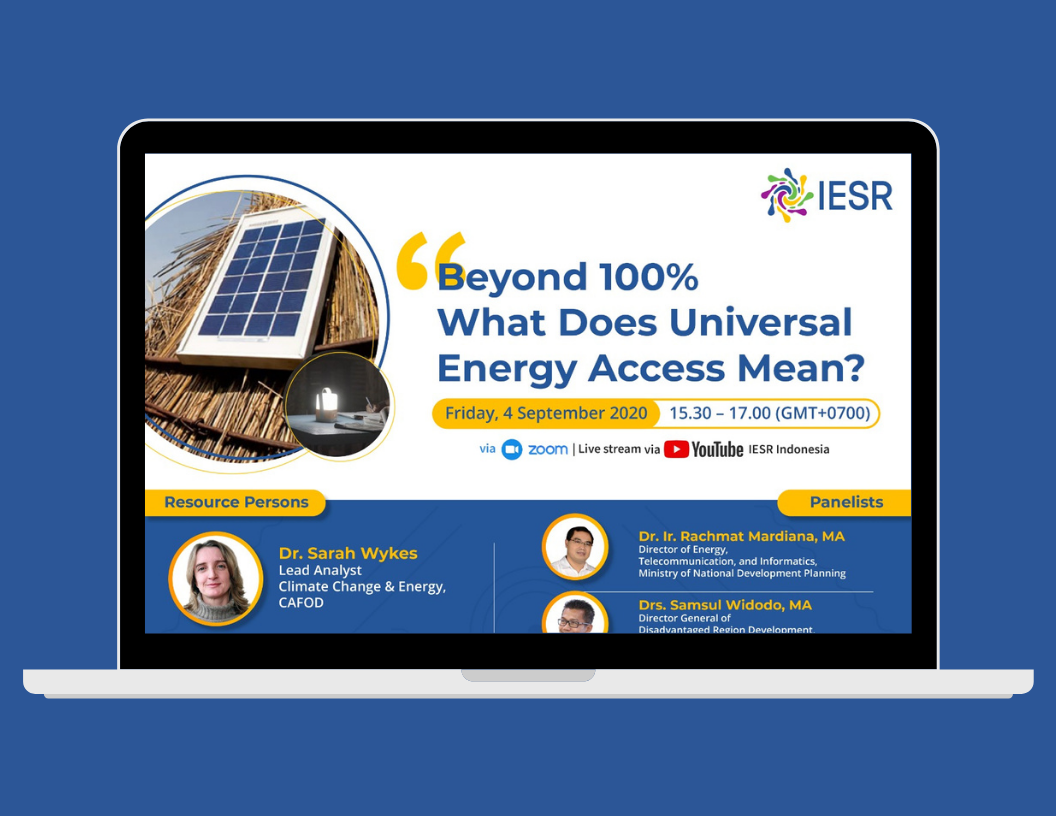The term “energy access”, while widely used to underline modern development, has no single global definition. In global level, the definitions often cover 4 important aspects: connections (or at least for lighting), access to clean cooking energy, energy for productive uses, and energy for public services. The importance of energy access for modern development has been integrated in The UN’s Sustainable Development Goals, i.e. SDG 7, and is being tracked regularly every year. With the importance of defining energy access, IESR held a public webinar on 4 September 2020.
In May 2020, The World Bank (with several agencies) issued a report on global energy access status Tracking SDG 7: The Energy Progress report 2020. In this report, highlights for Indonesia include significant developments on three main targets: availability of electricity (based on electrification ratio) and clean energy for cooking, utilization of renewable energy, and energy efficiency. However, based on IESR’s analysis, this good development should be considered with several notes.
Energy access in Indonesia is often narrowly interpreted only as a connection to the grid, access to LPG distribution networks, or the availability of basic lighting. However, as essential services, energy access should be able to contribute to poverty alleviation, economic growth, and general development agenda. Beyond the basic needs for daily activities, that often tend to be consumptive in nature, the provision of energy is a driving force for productive activities; whether on a household scale, in the case of small and medium enterprises, and on a large scale. Access to energy is also important for education and health services. With better education and health, more windows of opportunity are opened, including opportunities to get a job or to an entrepreneurship.
In Indonesian context, “quality energy access” has yet to enter mainstream energy discourse, for both electricity and clean cooking. With government’s plan to achieve 100% electrification this year, it is then necessary and timely to introduce access beyond connections – as to influence future planning related to energy access. Lessons learned from other countries on integrated energy planning are needed, specifically to answer the gaps in considering quality and community context to energy provision.
Dr. Sarah Wykes from CAFOD explained the importance of an inclusive and integrated energy planning as to answer the needs for energy and its intended impacts. Building Energy Delivery Model (EDM) with IIED, Sarah elaborated on interventions on energy should cover maximum impact, sustainability, as well as scalability. From her experience, planning in national level was not always delivered seamlessly into sub-national level; thus EDM could fit the “translation” process – as it allows community and the government to work together in identifying needs and solution. EDM is currently being piloted in Indonesia and also being used for Kenya County Energy Planning. The 6-steps toolkit of EDM is useful to map energy needs, prioritization, available resources, as well as potential collaborators to implement the solutions – Kitui County in Kenya was applying this to develop their mid-term energy planning.
Fabby Tumiwa of IESR told the story of EDM pilot in Indonesia. Boafeo, a village in Ende (East Nusa Tenggara) was chosen based on multi-criteria assessment. Upon energy needs assessment, Boafeo community identified 3 priorities: increased income from coffee production, better energy for household, and education outcome improvement. These choices showed that “energy access” is not confined under lighting need or simply connection – but on how the energy would play a part in the whole ecosystem. In the case of Boafeo, education is seen as important, and with the multiple appearance of stunting, improving education quality could be made possible with audiovisual learning process – requiring electricity. Solar panels has now been installed in Boafeo School, along with complementary teachers training on interactive learning and creative class.
Rachmat Mardiana from Bappenas agreed that comprehensive energy planning is needed, also with the redefinition of energy access. Bappenas is now developing a platform for energy planning with the aid from development agencies to obtain renewables-based least-cost electrification in eastern Indonesia. The platform embeds multi-tier framework adoption, covering quality energy access beyond connection. Faridz Yazi from Ministry of Village also elaborated on “village development” as seen from promoting local economic potential, and energy access is much needed to boost the process. With the availability of Village Fund and programs from Ministry of Village, local renewable development and integrated energy planning is possible – in collaboration with relevant stakeholders and with capacity buildings for village government and community.
Wahid Pinto Nugroho from Ministry of Energy and Mineral Resources took the time to show MEMR’s planning in establishing more accurate database and mapping for energy needs, using GIS-based platform. The challenges in energy planning include data validation and other socio-economic indicators, thus the platform will serve as comprehensive database for future program. For short-term measure, MEMR is currently rolling “power tube” – a portable rechargeable tube to provide basic energy access for remote areas. He mentioned that in the long term, more sustainable energy sources tailored to people’s needs will be arranged.
From the private sector, Jaya Wahono of Clean Power Indonesia shared his story in promoting renewable energy access for community. In his opinion, Indonesia needs “fit for purpose” energy solution: using local renewable energy with minimum damage to the environment, dispatchable and scalable, also reliable and sustainable. His company has worked with community to provide biomass for local electricity generation, and this scheme could be replicated in Indonesia with several prerequisite, including funding and financing scheme, technology readiness, and local employment benefits.
Recording of the webinar is available here and the slide decks are available in this link.

